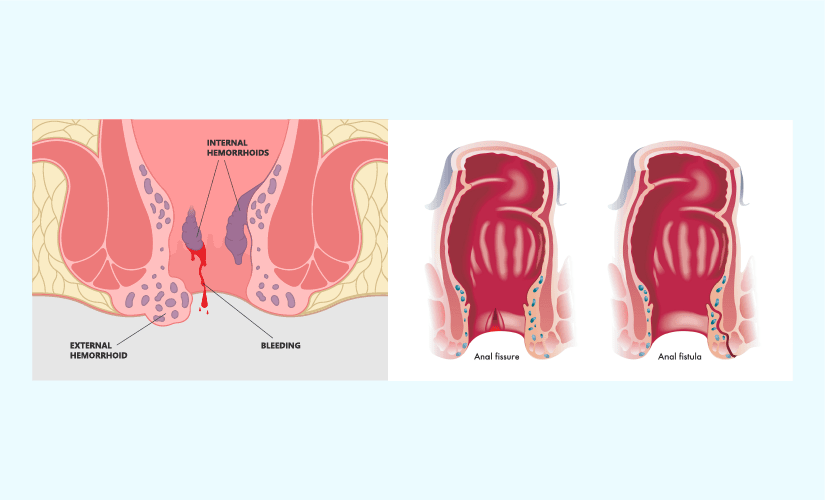
Difference Between Piles And Fistula
At the end of the rectum lies the anal orifice. Numerous disorders can affect the anus, which is the passageway through which feces exit the body. There are two most prevalent disorders: piles and fistulas. There is often confusion between them.
The article discusses the differences between piles and fistulas, which affect the anus. Dr. Hemant Garg, a renowned expert in Proctology, sheds light on eight unsuspected habits that can lead to piles and offers insights into prevention strategies. He provides Piles Treatment and Fistula Treatment and Fissure Treatment services at SDMH Hospital, Rambagh, Jaipur.
Piles
The term piles or hemorrhoids refers to enlarged veins. There are three types of thrombi: external, internal, and thrombosed. Excessive feces passing, obesity, and protracted toilet use can all contribute to the development of piles.
As the name indicates, internal hemorrhoids occur within the anus. Therefore, it is difficult to see them. Anus hemorrhoids have the potential to bleed. Hemorrhoids that develop on the anus’ exterior, on the other hand, are known as external hemorrhoids. They can be seen with the naked eye.
As a result of an exterior hemorrhage forming a blood clot, hemorrhoids have become thrombosed.
Fistula
A tunnel connecting an abscess inside the anus to a section of skin around the anus is known as an anal fistula. As a result of an obstruction in the anal glands, an abscess forms. If left untreated, it may grow and turn into a fistula.
Piles vs. Fistula: Understanding the fundamental distinctions
To better comprehend how fistula and piles differ from one another, let’s examine some elements of these two medical conditions:
Type of the condition
The blood vessels swell up in piles, whereas a fistula is characterized by the growth of a tunnel from the anus to the surrounding epidermis.
Reasons for the condition
A lack of water intake, pregnancy, obesity, eating low-fiber foods, straining when passing feces, and spending a lot of time on the toilet seat can cause piles. Additionally, lifting large objects can cause it. A person’s age increases their chances of developing the disease. The risk of pile development increases in expectant mothers as well.
A fistula can be caused by rectal cancer, urinary tract infections, sexually transmitted diseases, or Crohn’s disease, among others. The risk of getting a fistula is higher in people who already have HIV (human immunodeficiency virus), diabetes, anal trauma, Crohn’s disease, or tuberculosis.
Signs of the condition
Soreness around the anus, pain during excretion, feeling constipated, bleeding from the anus (often without any pain), and mucous discharge are the primary signs of piles.
The primary symptoms of fistula include skin rashes in the affected areas, pus or blood discharge close to the anus, pain while urinating, and anal swelling. A fever may develop as well.
Identification of the condition
An atypical growth in the anus will often be detected through a physical examination by the doctor. Additionally, they could use equipment like a proctoscope. The doctor may recommend a colonoscopy if they suspect cancer or other digestive health problems.
A doctor usually uses imaging tests in combination with a physical examination to diagnose fistulas. If the doctor finds the anus to be enlarged, he or she may recommend a colonoscopy or an X-ray.
Treatment strategies
Medication or surgery can be used to treat piles. Some people may find relief from the symptoms by applying cream to the affected areas. Furthermore, they may be prescribed oral painkillers by their doctor. Rubber band ligation and infrared or laser coagulation are sometimes used to treat hemorrhoids. It is possible to perform a hemorrhoidectomy on severe piles. There are two options when it comes to the type of anesthesia for a hemorrhoidectomy: local or total. Hemorrhoid patients are advised to consume more fiber-rich foods.
A minimum of eight glasses of water must be consumed each day as well. No medication can cure fistulas. The only course of action available to the patient is surgery. Fistulotomy is the name of this procedure. For the fistula tunnel to heal, the surgeon merely opens the surrounding muscles and skin. A seton that aids in draining the fistula before the surgery may be needed for more complex fistulas.
Conclusion
Dr. Hemant Garg emphasizes the importance of recognizing and modifying habits that contribute to hemorrhoid development, such as prolonged sitting, straining during bowel movements, and engaging in heavy lifting. Dr. Hemant Garg is the most reputed Fistula Treatment and Fissure Treatment in Jaipur and has years of work experience and is the Best Piles Doctor in Jaipur for Fissure Surgery and for such as Fistula surgery and Piles Surgery.